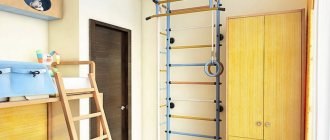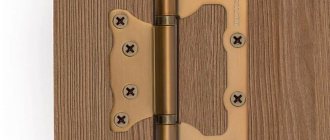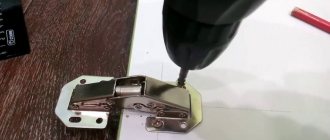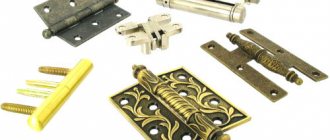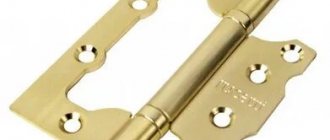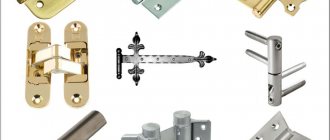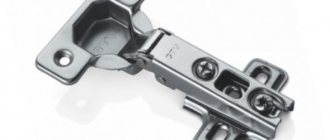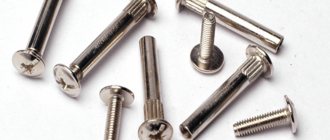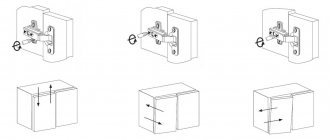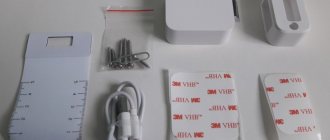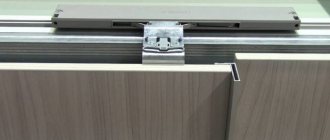The opening mechanism of x cabinets is the most vulnerable point in the design of kitchen furniture. Therefore, choosing reliable and durable hinges is no less important than choosing other high-quality materials for the kitchen.
What kind of hinges are needed for kitchen cabinets? The choice depends on their purpose, method of fastening and design.
A furniture hinge is attached to the body and door, which serves as a means of connecting two structural parts and as a mechanism for free opening/closing at a specific angle.
You can see the types discussed below in an accessible, understandable and visual way in the video review:
Corner furniture hinges
Door hinges are the main element of furniture cabinets of any size and any purpose. They come in various types, differing from each other in design features and purpose.
The most popular are the four-joint ones because they are durable and last a long time. They are divided into two types: straight (with an angle of 90 degrees) and angular (all other non-standard angles). Corner furniture hinges are used in sets when assembling corner cabinets.
- How to choose the right ones?
- What types of corner hinges are there?
- Negative angle
- Corner hinge design
- How to choose suitable corner hinges?
- How to install correctly?
Overview of species
With the expansion of the range of available furniture products, hinges for its installation have also received a certain development. Universal non-mortise models can be installed without milling. They are focused on wood-based panel materials, which usually have a decorative coating - where removing part of the surface is a serious problem.
Hinges that do not require insertion are usually classified according to the type of design and purpose of the product.
By design
The structural features of furniture fittings are the main feature by which they are usually divided into categories. The most popular options for hinges that do not require insertion are worth considering in more detail.
Eight-joint cups. They are considered a universal option used when assembling furniture. They have a wide selection of standard sizes.
These are the main options for furniture hinges, which do not require additional insertion into the facade during installation.
But even home craftsmen who do not have special training can fix such elements on cabinet doors or their bodies.
By purpose
The classification of all existing hinges installed without insertion also takes into account the purpose of such products. Among them are the following.
Furniture hinges. With their help, framed and frameless facades and other swing elements are mounted, in which it is quite difficult to make a hole without damage.
Furniture hinges are the most compact of the options presented. Their recommended loads rarely exceed 20 kg.
What types of corner hinges are there?
- overhead (internal), fixed inside the cabinet;
- overheads located on the facade and covering the side of the body when open.
- 30 degrees
- 45 degrees
- 120-135 degrees
Such hinges are mainly required in chamfered end corners where a wider opening is not possible. It is installed at an angle of 120 degrees, which is why it is sometimes marketed as “Grasshopper”.
Such furniture hinges are needed for trapezoidal cabinets. They are mounted at an angle of 135 degrees (there is a marking “135 degrees”).
Typically, such a furniture corner hinge connects two facades fastened together.
Negative angle
Such loops are difficult to find in stores because they are in little demand. They are used on end cabinets on the outer door, which is more convenient to open from the opposite side. But sometimes the only suitable option is just such a furniture hinge.
These are the standard and most popular parameters for corner hinges. If necessary, the opening angle can be made to any size, but to do this you will have to contact specialists who make custom-made furniture hinges, indicating all the desired parameters (size, material, opening angle). The downside to this is the higher price compared to buying traditional corner hinge options in a store.
Corner hinge design
These hinges have adjusting bolts, with which you can align the door on any side and along the angle of the rebate. They have a closer, thanks to which the door closes smoothly. This increases service life due to the fact that the mechanism wears out more slowly than if the sash were to slam shut abruptly.
Four-hinge hinges
The most widespread in the production of cabinet products intended for the arrangement of any residential and domestic premises are four-hinged hinge structures, the advantages of which are:
- high strength of individual elements, ensuring reliable operation of the product as a whole;
- a large number of operation cycles, ensuring the operation of the product during its entire service life;
- Possibility of adjusting the door leaf in three planes.
The design of the four-hinged hinge includes:
- cup;
- shoulder;
- installation site;
- additional elements - an adjusting screw and a decorative flange.
As a rule, the cup is installed in a special recess milled in the door. In order to reduce the range of cutters (Fosner drills), most loop specimens have a cup with a diameter of 35.0 millimeters.
Cups with a smaller diameter (26.0 millimeters) have models designed for installation on door leaves that are small in weight and size, as well as on hinged glass doors, such as in sideboards. The lever arm is the body of the adjustment mechanism and is connected to the installation platform, fixed inside the furniture compartment, on its sidewall. Fastening of all elements of hinge fittings is carried out with self-tapping screws or using a screw confirmation.
How to choose suitable corner hinges?
Corner hinges come in standard varieties, but if necessary, any other opening angle can be made to order. The main selection parameter is the location of the cabinet relative to others and the available space for opening it.
Traditionally, furniture doors are opened by a closer at an angle of 90-110 degrees; in these cases, straight hinges are used. When it is necessary to go beyond this range, corner hinges are required. If the desired angle is wider, then you need to look for options marked “plus”; if narrower, then “minus”. If the non-standard angle is not a multiple of 5, then along with the hinge you will have to install a special pad to help adjust the angle.
How to install correctly?
The Pythagorean goniometer is an auxiliary scale designed for calculations in preparation for installing corner furniture hinges. You can buy it at a specialty store or make it yourself using thick cardboard. Otherwise, you will have to measure everything yourself.
The flat side of the protractor must be leaned against the place where the hinge will be located and mark the place where it will rest against the lower part of the body from below.
First you need to install the hinge on the door, and place the striker on the wall. This is done on the basis of preliminary marking, during which the installation point of the loop is indicated. All you need is a ruler and a simple pencil. Having determined a suitable location, you should drill a hole to secure the cup. Its size will be equal to the thickness of the loop. Usually it is 11-13 mm.
Then you need to determine where the hinged element will be attached. To do this, install the loop in a pre-drilled hole and mark with a pencil the points where the fasteners are located.
It is better to use a template, and then you will not have to waste time making a separate calculation for each loop.
Using a drill corresponding to the size of the fastening elements, you need to make holes for the fastenings, after which you should install the hinged part of the hinge and secure it to the facade.
The next step is to determine the location of the strike plate. The cabinet door must be leaned evenly against the body and the corresponding point must be marked. It is important to remember that if there is any inaccuracy or mismatch, the hinge will not be installed correctly and the door will not be able to open and close.
A hole is also drilled at the marked point where the strike plate is secured.
The last step is to adjust the opening angle, if necessary.
The installation of corner furniture hinges is similar to the installation of straight hinges, with the exception of the need to additionally take into account the opening angle.
Kitchen cabinet hinges
The opening mechanism of x cabinets is the most vulnerable point in the design of kitchen furniture. Therefore, choosing reliable and durable hinges is no less important than choosing other high-quality materials for the kitchen.
What kind of hinges are needed for kitchen cabinets? The choice depends on their purpose, method of fastening and design.
A furniture hinge is attached to the body and door, which serves as a means of connecting two structural parts and as a mechanism for free opening/closing at a specific angle.
You can see the types discussed below in an accessible, understandable and visual way in the video review:
Features of purchasing custom-made kitchen furniture- Choosing the perfect sofa
- Upholstered furniture in Perm
Areas of use
The use of furniture hinges without mortise may be determined by the type of product design or the materials used. These can be thin doors in frames made of chipboard or plywood, or other options in which drilling holes is somewhat difficult. Special non-mortise hinges are produced for glass elements; you don’t even need to drill holes for them. For aluminum structures, fittings are often supplied immediately complete with the furniture profile.
The use of such fasteners is most in demand when assembling cabinet furniture, built-in and conventional, free-standing. Options without drilling are mounted like clamps, securing the blade in a kind of groove. They are in demand when assembling display cabinets with a large glazing area.
What types of hinges are there for kitchen cabinets?
Among the entire range of designs
There are only 2 types.
- Hinged (piano and card). These were the very first to appear; they were used back in the last century, but are practically not used in modern headsets. But when assembling antique retro or vintage furniture, they may just be needed.
- Four-jointed. Their design differs from previous conventional ones in that they can be adjusted in several places, ensuring free opening/closing of doors.
Four-hinged design device
Hinges according to door position and fastening method
The semi-overlay allows only partially covering the body of the furniture set. It has a slight bend that creates a gap between the sashes, which allows you to open two adjacent sashes at the same time. Used in intersectional fastenings of kitchen furniture, for example in a three- or two-door cabinet;
- overhead (external) are a hinge mechanism that allows the doors to open 900, actually 105 degrees.
They are most often used for fastening doors in kitchen units. They allow the doors of cabinets and sections to be tightly closed, covering the body on both sides, and serve for a long time without breakdowns;
Note! DIY decorative table
- internal (inset).
They have a large bend, which helps to move the inset door outside the body when opening. Rarely used for attaching heavy doors to chipboard cabinets. They allow you to sort of recess the doors when closed behind the cabinet body;
Beds with soft panels at the head: stylish solution and comfort- Ideas for arranging furniture in a small room
- Is it possible to place a bed opposite the door?
- adit (straight)
are designed for attaching the front part to the sidewall of false panels.
Often used in corner sink cabinets.
Corner
For installation in corner floor and wall cabinets, hinges are needed that allow the doors to be opened at different angles.
Hinges depending on the opening angle and purpose in the table:
in sloping end cabinets
Carousel (inverse) loops deserve special attention
. Thanks to their design, they allow doors to open up to 180 degrees.
They are not used so often in corner cabinets.
- How to sell furniture active sales?
- Adhesive paper for furniture
- How to attach a countertop to a kitchen unit?
For cabinets with vertical opening
These are mezzanine loops. Their main element is a spring, they are installed on the doors of hanging cabinets with a vertical opening.
For glass doors
Depending on the material on which they are installed, we can separately distinguish those that are mounted on glass surfaces. Their main difference is the presence of a special decorative lining that masks the loop. True, at home it is quite difficult to drill a hole for them.
Hinges for glass doors are also divided according to the opening method, angle, etc.
Hinges can be equipped with additional elements - closers. Closers can be built-in or come separately as a set.
With door closer
What are they?
Ombre loops come in overhead and inset cylindrical types. Overlays are installed on the ends of the sashes in cases where the facades are thin, and installation of mortise elements that are less noticeable on furniture is not possible. The cylindrical hinge is convenient because it can be hidden inside both the end part and the folding part of the product. The fittings are often coated with zinc, which reliably protects metal structures from corrosion, and they can also be made of zinc alloy.
The cylindrical loop has design features. It is a rotating device and cannot withstand heavy loads, so it is not used for large structures. However, the metal part will be hidden when the table is unfolded, which will provide an attractive appearance to the product. Cylindrical hinges can be used for different facades: chipboard, MDF, solid wood.
Product sizes may vary. It is designated by markings, for example, D12, D14, D16, D24. Quite often the option with a diameter of 14 mm is used, since this value is optimal for the thickness of the fabric from which the doors of folding tables are made.
How many hinges do you need to buy to securely install the door?
To install hinges on doors yourself, first of all, you need to determine the required number of devices. It depends on the dimensions and weight of the door being hung, as well as the material from which it is made.
How many pieces do you need to buy depending on the weight and height of the facade?
In order for the hinges to fully cope with their assigned task - to ensure the free opening/closing of doors without creaking or moving, they must be installed correctly. Usually, instructions are always attached to the product.
The video will also help you understand the installation principle:
Proper furniture maintenance
To ensure long-term and trouble-free operation of furniture canopies, it is not enough just to install and adjust them. Proper operation and regular lubrication are also important.
Following these recommendations will help maximize the life of your hinges:
- Frequency of adjustment. The first time setting up the canopies is done after installing the furniture. The following adjustments are made depending on the intensity of use of the cabinets. In one case, this will have to be done 4 times a year, in another, once is enough. If distortions or other problems with the sashes are identified, there is no need to wait for scheduled maintenance; the identified violations must be corrected immediately.
- Lubrication. To reduce friction in the moving elements of door hardware, they require periodic lubrication. This is done once a year or if there are any extraneous noises, squeaks or difficulties when opening/closing the doors. For lubrication use machine oil of any type (synthetic or mineral). A few drops of special lubricant (for example, WD-40 or similar) is enough.
How to choose corner hinges
To select corner hinges for furniture doors, you need to determine:
- type of loop;
- required opening angle.
Types of loops
Corner hinges for furniture can be:
- internal or inset, installed when the door front is located inside the cabinet;
Furniture hinge for the door located inside the cabinet
Furniture hinge for external cabinet door
All types of corner-type furniture hinges have a number of features:
- allow adjustment in three main directions. To do this, special adjustment bolts are installed on each hinge, by rotating which you can align the cabinet door vertically, horizontally and set the optimal rebate size;
How to adjust hinges after installation
Furniture hinges, complemented by a built-in closer
Determining the opening angle
The standard opening angle for furniture hinges is considered to be 95º-110º. If it is necessary to increase or decrease the opening angle of the cabinet door, then the installation of corner furniture hinges is required.
Each corner loop is marked with the sign:
- plus if the opening angle exceeds the standard. For example, an angular hinge 45+ means that the door can be opened to 135º;
- minus if, with the hinge installed, the door opens at an angle of less than 90º. For example, a -45 hinge helps the door open 45º.
Device for determining the angle of a furniture hinge
To determine which hinge is required to install corner cabinet doors, use a special scale called a Pythagorean protractor.
The principle of working with the scale is extremely simple:
- the flat part of the protractor is attached to the cabinet box on the side where the hinge is supposed to be installed;
- The scale on the tool will tell you at what angle you need to purchase the loop. In this case, the optimal angle value will be located level with the lower side part of the cabinet box.
Determining the angle of a loop using a Pythagorean protractor
How to install hinges
The corner furniture hinge consists of:
- hinges equipped with a cup and housings with an installation groove;
- strike plate.
Elements that make up a corner furniture hinge
Installation of corner hinges is carried out according to the following scheme:
- Marking. First of all, the location of the hinge on the door is determined. The optimal distance is considered to be 70-120 mm from the edges of the facade. Using a pencil and ruler, mark the area for installing the hinge cup. The distance from the center of the cup to the edge of the door should be 20-22 mm.
Determining the location of furniture hinge cups
- Using a drill and a special attachment, a hole is drilled for the cup. The depth of the groove should correspond to the thickness of the loop. Most often, it is enough to make a hole 12.5 mm deep.
Preparing the hole for installing the hinge cup
- At the next stage, it is necessary to determine the location of the fastening elements of the hinged part of the loop. To do this, the loop is installed in the prepared hole and the locations of the fasteners are marked with a pencil.
Determining the location of the mounting bolts
Devices to facilitate marking when installing furniture hinges
- Using a drill with a drill that maximally matches the diameter of the fastening bolts, holes for fastening are drilled.
- The hinged part of the hinge is installed and attached to the door facade.
Fixing the hinged part of a furniture hinge
- Next, mark the installation location of the striker plate. To carry out this operation, you need to place the cabinet door against the frame and align its position. Using a pencil, mark the attachment points of the striker plate.
- The marked holes are drilled.
- The striker plate is being attached.
Installation of the strike plate on the cabinet frame
- If necessary, final adjustments are made.
The process of installing a furniture hinge is presented in the video.
The main aspect when choosing a corner hinge is to correctly determine the required opening angle. You can take measurements using a Pythagorean protractor, which is either purchased in a store or simply printed on thick paper. Installation of a corner hinge does not differ from the installation diagram of other types of furniture hinges.
Installation stages
Installation of hinges on facades is carried out in 4 stages:
- first create markup;
- then make holes using a drill;
- then installation is carried out, as well as assembly of parts of the fittings;
- At the last stage, the doors are installed.
Stages of self-assembly of furniture, rules for deciphering drawings The most important and difficult stage is considered to be adjusting the position of the door relative to the furniture body. If the work is done incorrectly, the sash will quickly sag and the cabinet (or any other product) will fail.
Creating markup
To install furniture hinges correctly, you must initially make even markings that correspond to the parameters of the hardware plate. Otherwise, there will be problems with opening and closing doors. The marking of furniture hinges is done as follows:
- The distance between the canopies should be at least 50 cm. At this stage, the number of hinges required is determined.
- Start marking the center of the canopy holes. At the same time, they retreat from the edge of the door by 2–2.5 cm.
- Marks are applied taking into account the width of the door. At the intersection points, holes are made with self-tapping screws. At this stage it is worth using a template for marking furniture hinges.
Despite the fact that templates for furniture hinges are made of durable materials, they must be handled very carefully. It is strictly forbidden to drill through them, otherwise the service life will be reduced. To determine the number of loops needed, it is worth studying the recommendations presented in the table.
| Door weight, kg | Facade height, mm | Recommended number of loops |
| 4-5 | up to 500 | 2 |
| 6-9 | 500-1000 | 2 |
| 10-13 | 1000-1500 | 3 |
| 14-18 | 1500-2000 | 4 |
| 19-22 | 2000-2500 | 5 |
Hole preparation
The next step will be preparing the holes. To make the notches correctly, you need to accurately follow the markings already made. To carry out this operation, a drill with a special drill and a milling cutter are used. The holes are made like this:
- First you need to lay the door on a flat surface.
- Fix a cutter for furniture hinges of a suitable diameter in a drill. The depth of the hole should not exceed 1.25 cm.
- During the drilling process, the drill must be positioned strictly perpendicular to the surface of the door.
- During the process of forming the hole, you need to carefully ensure that the cutter or drill does not drill through the door.
Nuances of making furniture drawings, review of useful programs
When the main holes for the screws are ready, you can move on to the next stage. Inserting canopies in accordance with the markings and formed recesses is much easier and of better quality.
Hinge Attachment
The hinges are attached in the following sequence:
- The part of the loop that will be directly attached to the facade is placed in the bowl.
- The hinges are carefully positioned in the recesses to ensure optimal placement.
- Using a construction angle and a level, achieve an even position of the loop in the cup.
- If you need to correct the hole to lay the canopy evenly under the level, use a furniture cutter to install the hinges.
- Using a screwdriver, screw the screws into the holes on the hinge itself.
After fixing the screws, you need to check the strength of the canopy. It is recommended to try to loosen the hinge in the cup and move it relative to the surface of the facade. If no changes are observed, then the fittings are secured well.
Hanging the door
The most difficult stage in this work is the installation of the door. To simplify the task, if possible, it is worth laying the furniture body so that the doors are attached to the hinges in a horizontal position. Algorithm for installing doors:
- In the inside of the furniture body it is necessary to make the same markings as on the door. To install the hinges, you also need a furniture bit.
- Next, secure the platform to secure the canopy using self-tapping screws.
- Connect the two parts of the canopy.
- Finally, adjust the position of the fittings relative to the door and furniture body. This can be done using a screwdriver and a level.
Making upholstered furniture with your own hands, tips for beginners
Hanging the door is not the final stage of work. Even after the initial adjustment, additional measures must be taken to align the position of all components.
Types and selection of corner hinges
- Kinds
- Opening angles
- How to choose?
Door hinges are considered the basic elements of furniture fittings for any purpose; they can have a variety of different designs. The most popular on the market are four-joint products - practical and reliable, with a long service life. They, in turn, are divided into two types: straight lines with an angle of 90° and additional angular ones, which assume all other non-standard angles. Such fittings have become widespread when assembling corner furniture modules.
Corner hinges are used to place the doors of hanging furniture structures - most often these are corner wardrobe cabinets and kitchen units. Such loops can differ in opening angles, and the angle has not only a numerical value, but also a certain shape (sharp and obtuse).
Corner hinges have adjusting bolts that allow you to align the sash on any side, as well as along the angle of the rebate. They have a built-in closer, which makes opening the door as smooth as possible. This design significantly increases the service life due to the fact that the mechanism wears out much more slowly than when the sash is suddenly slammed shut.
Note! Country outdoor table
Corner hinges are:
- internal - such fittings are fixed inside the wardrobe;
- overhead - they are placed on the facade and cover the side of the body when open.
Fittings with a closer are classified depending on the type of facade, as well as the installation angle relative to the body. Visually, they differ from standard ones only in the configuration of the shoulder, inside of which special shock-absorbing mechanisms are mounted. Depending on the type of product, the door closer can be built-in or overhead. For example, such hinges are offered on the market by Blum.
However, in the vast majority of cases, the models sold in stores do not provide for the possibility of their further improvement. Therefore, if you plan to install facades with soft closing without knocking, then it is better to immediately purchase hinge mechanisms with closers. Of course, they will cost a little more, but they will also last longer.
A separate category of corner hinges are models created specifically for use in glass facades - they can be with or without drilling glass.
In general, all produced mechanisms may differ from each other according to the following criteria:
- size;
- metal manufacturing;
- base material where the hinges are attached;
- detachable design;
- fixation methods;
- strength.
Materials for sliding doors
The most popular materials for the manufacture of sliding door systems today are:
- Tree
- Fiberboard or MDF
- Glass
Tree
The traditional material for the manufacture of not only doors, but also furniture in general, is wood. At the same time, both the entire panel (s) of the sliding door system and the frame for combination with other materials can be made from wood:
- Glass
- Plastic
- Paper
- Textile
- Mirror
The easy flexibility of wood to process allows it to be used for interior decoration in almost any style. Want a charming country room? Use unplaned wooden boards! Do you like classic style interiors? Choose a wooden door leaf with strict shapes. Are you striving to create an interior in a shabby chic or art deco style? Give preference to carved wood with forged elements or inlay. Are you a supporter of the East? Use canvases with a wooden frame and rice paper inserts.
Fiberboard/MDF
Since wood is not the cheapest material, it can easily be replaced by materials such as fiberboard or MDF. In appearance, they are almost impossible to distinguish from natural wood, but the cost is an order of magnitude lower than that of similar products made from natural wood.
Glass
Glass sliding doors are an excellent option for creating an interior in minimalist, futuristic or hi-tech styles. Due to the property of glass to transmit light, glass interior sliding doors do not create a feeling of total enclosure of space. Moreover, by choosing the degree of color and opacity of the glass for the door leaf, you can select the degree of transparency (and, as a result, integration with the neighboring room) of the interior doors.
Opening angles
Corner fittings are installed on corner furniture. In this case, the leaves are attached to the base of the door frame at a given angle. Such hinges allow the doors to open at 30, 45, 90, 135, and 175 degrees. The following options are most widespread.
- Angled hinge at 30°. Fixed to the facade located at 90+30 degrees relative to the body. Mainly in demand in end cabinets of dressing rooms or in kitchen sets. The installation angle is 120°, so some manufacturers mark similar products by installation - they go on sale under the name “120 degree loop”. Popularly, these models are better known as “grasshopper”.
- 45° corner hinge. Used in single and double door wardrobes. As a rule, furniture of this type is present in dressing rooms and kitchens. It is fixed at an angle of 135°, which is why it is labeled by some manufacturers as a “135 degree hinge.”
- Angled loop 120-130°. Found application when connecting pairs of facades connected to each other at an angle of 270°. This type of hinge opens like an accordion.
- It is less common to see hinges with a negative angle at points of sale. They are not widely used on the market; they are used mainly on the outer door of the end cabinet, which is easier to swing open from the opposite edge. There are situations when such a loop becomes the only available option.
The listed types of corner hinges belong to the category of standard and most common. If necessary, you can set any other opening angle, for example, 60, 15 or 25 degrees. In this case, you will have to contact the craftsmen who make these to order. They will make fittings taking into account the customer’s data: size, desired opening angle and material. The disadvantages of this solution are the relatively high cost and time spent on producing the optimal model.
How to choose?
When purchasing corner hinges, the basic selection criterion is the angle of the cabinet relative to other pieces of furniture, as well as the free space available for swinging it open. Most often, furniture doors are opened using a closer at an angle of 90 to 110 degrees. In this case, straight loops are used. Angular ones are needed when you need to go beyond the specified range.
If the opening angle of the sash is greater, you should choose a product marked “plus”; if the angle is lower, then, accordingly, “minus”. In a situation where the non-standard angle is not a multiple of five, it is necessary to additionally mount a special attachment that will allow you to adjust the optimal opening angle.
The following video talks about hinges for furniture assembly.
Types of furniture hinges by design
There are many hinges and canopies used to attach a swing door to the frame of a cabinet or cabinet. Basically, in modern furniture production, four-hinged hinges , which allow the facade to be adjusted in three planes at once:
- higher lower,
- left/right,
- to/from the facade.
All of them consist of two interconnected parts - a bowl with an elbow and a strike plate . Often the strike plate is called a mounting or mounting plate. This article will focus specifically on four-hinged hinges.
Other types of furniture hinges can be combined into one large group as “bowlless” hinges.
piano hinges, card hinges, pin hinges, and heel hinges, known to everyone for fastening interior doors and facades in old furniture . They are rarely used in modern furniture. For example, piano, card and mortise hinges can be used to attach tabletops to the base, movable legs in book-tables. For ordinary cabinets, brass decorative hinges are used as additional decor.
Overhead hinges that do not require drilling of the facade . They come in handy when the thickness of the material chosen for the facade does not allow installing (embedding) a four-hinged hinge due to the depth of the bowl. The only drawback of such hinges is their rigid fastening, which does not allow adjustment in three planes, like four-hinge hinges.
Hinges for fastening specific facades . For example, prefabricated facades made of aluminum frames of different widths are installed on special hinges - you can purchase them together with the profile. Please note that, just like regular four-hinged hinges, they can be overhead or internal, designed for corner cabinets of 45, 135, 180 degrees and facades covering the end of the case.
Rarely used and “old” furniture hinges for cabinets
In addition to the four-hinge furniture hinge, other types of hinges are also used. They do not allow the possibility of adjusting the facade - this is their main drawback.
Card, card, pin and piano furniture hinges
This type of hinged furniture hinges is used when installing a conventional four-hinged canopy is impossible. Or do you need some other type of opening mechanism - a flat or pin design, without protruding elements inside the body.
| Card furniture hinge – flat, for installation on the end of the facade and the end of the body. It can be mortise (with a recessed platform) and overhead, simple design and decorative. There are also complex knee card hinges that provide different opening angles and methods. | |
| The piano hinge also refers to flat hinge hinges; most often it can be seen in the fastening of hinged lids and tabletops of cabinets and book-tables. | |
| Card or adit hinges can be found on folding bar doors. Installed at the end of the door. | |
| Pin or screw-in hinges are also a type of hinge hinge. Most often they are used for installing interior doors; in furniture production using laminated chipboards they are absolutely inapplicable, since particle board is not capable of holding such a pin connection. | |
| Gate hinges are also used extremely rarely in furniture production. It can only be found on heavy solid wood products, decorated in an antique style, various chests and sideboards. |
Furniture hinges for cabinets without mortise
Sometimes the thickness of the facade does not allow the use of cup hinges. Special furniture hinges for cabinets without mortise come to the rescue. Strictly speaking, all overhead hinges discussed above - piano hinges, card hinges, etc. - can be included in this category. Their only difference is that furniture hinges for cabinets without an insert of this type will be visible. If a standard design of the cabinet facade is required, without protruding parts of the canopies on the front or end side, then we recommend using a furniture hinge without an insert of this type.
Secretory furniture hinges
Folding bar doors often serve as a kind of work surface integrated into the cabinet. To implement this idea of transformable furniture, secretory hinges are used.
| The mezzanine hinge combines the functions of an opening mechanism and a locking mechanism in the open position. | |
| The mortise hinge is also a bowl hinge, but with its own installation specifics and functional role. |
Mortise hinges are much more compact than four-hinged hinges and can be designed for different opening angles, with overhead and internal installation of the facade. Also used for kitchen cabinets.
Types of four-hinged furniture hinges
According to the design, according to the way the bowl with the knee is attached to the striker, four-hinge furniture hinges can be of three types:
- Slide-on—the parts of the loop are inserted into each other and connected using a fixing screw that has special notches, thanks to which it reliably “holds” the connection even in a weakened state. This type of loop is the most common.
- Clip-on - the parts of the loop are connected by simple snapping, without screws. The facade can be removed and installed without using any tools - just pull the latch. Clip-on hinges are also called quick-installation hinges.
- Key-hole – on the shoulder of the bowl with a knee there is a hole resembling a key hole in shape - a keyhole. The arm and bar are secured by passing the head of the fixing screw through this hole.
Regardless of the design, all of the above types are divided according to their purpose and installation method - what facade is used in the furniture and how it is attached to the body.
90 degree hinges
*The designation 90 degrees in this case is conditional, it is used to mark hinges that open at a right angle. In fact, the door travel is somewhat greater, reaching about 105-120 degrees when opening. Some manufacturers and sellers of accessories may label this type not “loop 90”, but, for example, “loop 110” - there is no mistake here.
The 90 degree overhead (external) loop has a straight “shoulder”, without bending. Used for facades that completely cover the ends of the side walls of the body (without taking into account the technological gap, which can be 1-5 mm).
Half-overlay (middle, half-outer) loop 90 degrees , the shoulder of the bowl with the knee can be distinguished by a medium bend. Rarely used. For example, in kitchen two-row horizontal cabinets for attaching the bottom door and in three-leaf wardrobes for attaching the middle facade.
The 90-degree inset (internal) hinge is distinguished by a large bend on the “shoulder”, due to which the inset door is carried out when opened outside the body. Rarely used. For example, in office furniture, in which the body is made of thickened 22 mm chipboard and the internal facade emphasizes this detail.
180 degree hinges
A straight (gauge) hinge for false panels is designed for attaching the facade to the sidewall, which is located in the same plane. Most often used in corner kitchens, when using the appropriate corner sink module.
The 165-degree carousel (crab, crocodile, transformer) hinge is recognizable by the characteristic complex shape of the bowl's elbow, which ensures that the door opens completely relative to the body - almost up to 180 degrees. It can also be invoice, semi-invoice and inlay. Differs in the shape of the shoulder.
Types of corner hinges
A 30-degree corner hinge “presses” the façade, located at an angle of 90+30 degrees relative to the body. It is most often used in beveled end cabinets of kitchen units or wardrobes. Installation angle – 120 degrees. Some manufacturers mark it by installation angle, i.e. called a 120 degree loop.
The 45 degree corner hinge is used in trapezoidal single and double door cabinets - for example, kitchen or dressing rooms. Similar to the previous type, it can be called by the angle of installation - a 135 degree loop.
An angular loop of 120-135 degrees most often serves as a connection between two facades, fastened together at a right angle of 270 degrees, which come off like an accordion. In this case, the door without a handle is attached to the body using a carousel hinge from the previous category.
Corner hinges with a negative opening angle are used extremely rarely, due to design features: end cabinets, as a rule, serve as the end of a row of furniture and it is more convenient to open the door from the other side. But there are projects in which it is more expedient to implement the opposite solution.
The photo shows the main types of standard furniture hinges, without closers , ensuring smooth closing. Hinges with closers are classified similarly - depending on the type of facade and the installation angle relative to the body. They differ in appearance from standard ones only in the shape of the shoulder, inside of which a special movement-absorbing mechanism is built. Also, the closer may not be built-in, but overhead - as, for example, a manufacturer such as Blum offers. But the bulk of offers on the market still do not imply the possibility of improvement. Therefore, if you are determined to install facades with soft closing, without annoying knocking, purchase fittings with closers right away. True, it costs a little more. Before purchasing, I recommend that you read the review on furniture hinges with closers.
A separate group of furniture hinges is for glass facades, with and without drilling glass. Review on glass hinges here.
Furniture hinges for cabinet doors: how to choose a model with a 45, 60 and 90 degree closer
In modern production, a large number of accessories are used. In this article we will look at furniture hinges for cabinets. These are mechanical devices for opening and closing swing doors. There are many different models sold in stores, and before purchasing, it is advisable to know which option will suit your facades. We will tell you about the design and installation features of canopies.
Types of loops by design
They are hinge units that connect the doors to the cabinet body. Various design solutions make it possible to leave the door leaf open at a certain angle. Based on the method of fastening facades, you can choose the following models:
- Four-jointed.
- Mezzanine.
- Pianos.
- For glass doors.
Quadruple joint
The most common and popular are 4-hinge furniture hinges. They are distinguished by their versatility and high reliability. There are three types of four-hinged hinges, which differ from each other in the method of fastening the shoulder cup to the striker:
Slide-on. The protruding part of the strike plate fits into the shoulder. Fastening is carried out with a fixing screw. The connection has notches on both sides. The length of the arm can be lengthened or shortened by securing the connection with notches.
Clip-on. This system allows you to do without a screw. The parts of the loop are connected by a latch. Such canopies are called quick installation models. The cabinet door can be removed and replaced without tools.
Key-hole. The cup arm is placed with a hole on the counter plate screw. The edges of the opening are inserted under the screw. The mounting hole resembles a keyhole.
Their varieties are used depending on the position of the closed door relative to the wall of the cabinet body. There are the following four-hinged types:
- invoice;
- semi-invoice;
- loose-leaf;
- corner;
- inverse;
- adit.
Invoice
When the door is closed, the hinge fits tightly onto the end of the side wall of the cabinet. They are mainly used en masse in rectangular designs of kitchen furniture. The loop consists of a cup with a shoulder and a striker plate. How both parts are connected can be seen in the figure.
Overhead rotary hinges are installed in bedroom and living room closets, bedside tables and chests of drawers. The mechanisms ensure a tight fit of the doors to the entire perimeter of the furniture opening.
There are overhead mechanisms that do not require deep excavation in the facade mass. They are used when the thickness of the door leaf does not allow making a full recess for the cup. The hinges are fastened without insertion only with screws.
Half waybill
Such designs are used when hanging doors on one wall on both sides. They are placed in wardrobes of several sections, separated by partitions, so that adjacent facades do not interfere with each other when opened. For this purpose, the shoulder is made with a slight bend. The part allows you to maintain dimensions between open sashes of 5 - 10 mm.
Insert
The internal or inset design is designed so that when the door is closed, its facade becomes inside the cabinet opening at the same level as the end of the side panel. The minimum opening angle for the door leaf is 90 degrees.
Unlike previous models, the shoulder of the inset design is more curved. The installation of inset hinges is no different from the installation of other 4-hinged models.
Corner
You should install hinges for corner kitchen cabinets where you want to hang the doors at a certain angle to the side of the cabinet. Various models are designed for installation angles of the facade in relation to the side of the body of 30, 45, 90, 135 and 180 degrees.
Select a corner hinge model using the following table:
| Closed façade corner | Cabinet design |
| 30 - 60 degrees | Beveled end housing |
| At 45 degrees | Trapezoidal body |
| 120 – 135 degrees | Two facades opening with an accordion |
Inverse
Carousel or inverse hinges (crocodile, crab, transformer) are designed to open cabinet doors almost 180 degrees. The open façade is in line with the plane of the load-bearing part of the body. The complex shape of the shoulder allows the door to rotate completely 165 degrees. The transforming loop can be of overhead, semi-overlay and internal design.
Shtolnaya
The straight or adit model is secured with a counter strip to the false panel of the cabinet. The panel looks like an additional strip installed close to the sidewall. Wall hinges are usually installed in kitchen cabinets and corner cabinets under the sink.
All types of four-hinged models from companies such as the Austrian Blum (BLUM), the Spanish Amig (AMIG) and other equally well-known manufacturers are equipped with built-in or overhead door closers.
The device provides slow, soft closing of doors without knocking. To do this, you only need to push the door slightly and it will continue to move slowly until it closes completely. You can install a separate door closer next to a simple facade opening mechanism.
Let's discuss this article together:
Click to cancel reply.
